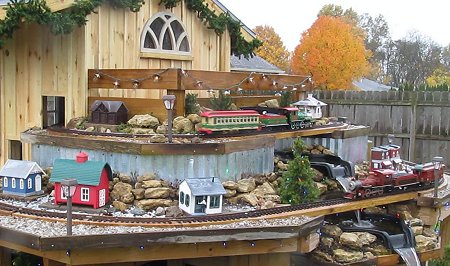 | |||
 |
 |  | |
 |  | ||
 |  | ||
 |  | ||
 |  | ||

| Please Read: How to Help Our Site at No Cost to You - Some of our articles contain recommendations for products we like and vendors we personally trust. Some of those vendors may pay us a very small commission if you click on a link and buy their products. This costs you nothing at all and helps offset the costs of what we do. So if we point you to something you decide to buy later, please make certain you come back through our site and click on the link directly. Thanks. |


|
Which Comes First, the Garden or the Train?I am writing this article in 2019, fifty-two years after LGB began the modern era of garden railroading by "leaking" prototype train sets to friends in the North American plant nursery business. To me, it's significant that the first family to own an LGB train in North America made most of their money growing evergreen trees. In a way, that shows that the connection between Large Scale ("G Gauge") trains and outdoor plantings goes way back to the beginning.Though the hobby is not growing as rapidly as it once did, Family Garden Trains' newsletter still gets more subscribers every week. So I think it safe to say that the appeal of trains running in an attractive outdoor setting is as strong as ever. The hobby should survive any bumps in the road as long as we can keep helping people fulfill their personal vision. That said, at the risk of offending other "old-timers" in the hobby, I'd like to suggest that we review some "lessons learned" and consider ways to make the hobby more rewarding to more families over the long haul. A big part of that will be admitting that it is a gardening hobby like, say, rock gardening, not merely a model train hobby that you can do outside if you need more room than you have indoors.
I know this runs contrary to 40+ years of what our gurus used to tell us (advice that I used to follow and even republish before I knew better): Decide first and foremost on what kind of railroad you want to emulate, then plan that, and then think about how to make it look like it's in a "natural setting." But if you design your garden and railroad holistically, you can change the kinds of trains you run or even the pretend time, place, and purpose of your railroad any time you wish. It's much more complicated, say, to move a waterfall. I do believe in planning a low-maintenance, compelling route for your trains, considering all the operational and expansion options you consider important. But getting the landscaping, gardening, and water features right the first time is just as critical.
There are a few hints and examples about planning the landscaping for your garden railway in our article "Landscaping Hints for Garden Railroads." Remember, though, those are just my suggestions. You really should branch out and study books on just landscaping, water features, and rock gardens to get a truly balanced perspective. Build for the Outdoors In the last few years I have also come to stress using construction methods and materials that will hold up as well, say, as the treated lumber on your deck or the concrete in your driveway. Sad to say, most of the splendid railroads my friends built when I was getting into the hobby in the 1980s and 1990s have been abandoned. The truth is, thirty or forty years ago, we had no idea how fast things could break down, come apart, or get overgrown in places like the American Midwest.
None of us knew. But we know now, and it's time to be honest about it. Starting small and solid is far more likely to keep people in the hobby for years than building an under-engineered "empire" the first year. I don't want to discourage anybody - it is possible to install a garden railroad that will provide decades of enjoyment with minimal maintenance. We just have to use appropriate methods and materials. Fortunately, when things started failing on my first "permanent" railroad, I was still young enough to rebuild my small waterfall, replace my gravel roadbed with concrete and replace disintegrating railroad ties with ground-rated lumber. (More of the rehab efforts are described in my April and August, 2010 updates.) Nowadays, I recommend using roadbed materials that weeds cannot possibly root in, be it solid concrete (like I went to with my old railroad when I refurbed it) or 2"x6" ground-rated boards (which I'm using now). I would have had many, many more hours to run trains if I had done this starting out. Unfortunately, many of my friends who had much nicer railroads at one time had older knees and backs when they were faced with similar challenges. They had no choice but to give up. I couldn't help wishing there was a better way. Better ways. "Running trains outside" should be the heart of garden railroading. It's time to start using methods and materials that let us do that without a workload that increases year by year. Don't Spend All Your Money on Trains - like the brides who spend their entire wedding budget on the dress, then have to have Little Caesars cater the reception, many people entering the hobby spend so much on trains they can't afford to create an attractive setting or reliable infrastructure for them.
By the way, as I write this, certain kinds of trains are getting harder to find or going up in price. Please don't let that discourage you. In the earliest days of the hobby, only one train was available - the one shown to the right. And many folks built spectacular railroads featuring that one train. Start with one "starter" train set if you have to, like an LGB or PIKO set. Save the 4' circle of track to put around the Christmas tree, then plan a railroad using much broader curves, as your space allows. Frankly, it's more fun to watch a 5'-long train travel a 60' loop of track than it is to watch a 15'-long train travel a 30' loop of track anyway. Choose or Prep Construction Materials for Longevity Today's garden centers include many products that, frankly, don't hold up more than a couple of years outside, be it:
Such products are designed to help you feel good about this year's backyard projects, while virtually guaranteeing you'll be back in a few years for more of the same. Anything that is going to be a "permanent" installation, such as posts in the ground, needs to be the same materials professionals use. Often, ironically, they only cost marginally more than the "disposable" stuff most folks buy, not knowing any better. For example, ground-rated 2"x6" boards in direct contact with the soil will last much longer than ordinary pressure-treated 2"x6" boards and seldom cost more than 15% more. If you think I'm exaggerating about the throwaway nature of "garden" marketing, take a good look at most commercial backyard garden sheds that have been installed for more than eight years. Chances are pretty good you'll find faded or flaking paint, mold or moss in places, warped doors, rotting floors and maybe walls. The same structure built with the right materials and finished properly may have cost 20% more. Choose or Prep Accessory Materials for Longevity Also, if you can figure out how to make your structures out of concrete, ground-rated lumber, or other materials that resist the weather for years on end, you might decide that zero maintenance trumps cutesy details. Yes, I've seen those diorama-quality scenes that are occasionally featured in Garden Railways, with so much detail you can identify the wrench types on the mechanic's tool bench and see the Xs marking off the days of the girlie calendar in the boss' office. They are great models, and in some way a hobby in themselves. But 99% of those never see actual weather, be it sunshine or rain. Your priority is an operating railroad in a compelling natural-looking setting that you can operate or display day in and day out with relatively little maintenance. If you can add extensive jaw-dropping details to the thing once the infrastructure and plants in place, that's great. But the truth is most folks in the hobby do one or the other, not both. I've experimented with concrete for structures and have yet to find a combination of methods and materials I would recommend. But other garden railroaders have had more luck.
If you "must" use something that's not really built for the long haul, take time to prep it before you set it out. For example:
Engineer for Longevity. If you are going to build a raised railroad (recommended) follow the same recommendations you would follow if building a deck or something similar. That is, if frost heave is an issue, be sure your posts go below the frost line of the existing soil. (Backfilled soil doesn't count - the frost line is still where it was for the first few years.) In some areas where the frost line is too far down to deal with, people build their decks in solid, cross-braced frameworks so the whole thing can rise and fall without losing integrity. Some garden railroaders have learned that the same approach works for them. A friend in Canada who has a ground-level railroad, has his 2"x6" roadbed pieces so firmly braced and fastened together that the whole railroad rises and falls with the frost, and is needs only minor tweaking to run trains each every spring. Plan for Limited Maintenance - In addition to using robust roadbed materials that will keep weeds from growing up through the track, keep the track within easy reach, especially any turnouts (switches). Also, figure out how to limit weed growth overall. My first "permanent" garden railroad was based on tips from people who lived in very dry climates and didn't see any potential problem with having something like 1600 square feet of places for things to grow. But from about the third year on, with Ohio's rainfall patterns, I had massive weed invasions multiple times a year, no matter what I did. Imagine having to weed an area the size of a small home five or more times a year. Is it any wonder I wound up with only a few running sessions a year eventually? You want desirable plants, yes, but if you have too many areas to weed, the garden will start requiring more maintenance than you really have time to perform. If you have areas, say, farther from the viewing areas, that don't really need to have scale plantings, you might consider either planting something coarser that will eventually crowd out the weeds (like Blue Rug Juniper), or dumping gravel over plastic sheeting or some such. Save the high-maintenance plantings for spots that are easier to reach and easier for visitors to see. My friends in desert regions insist that I'm overthinking this. But one Ohio family I know recently replaced several large hard-to-reach weed-prone areas of their railroad with high-end Astroturf. You may scoff, but it saved them from having to give up on the railroad altogether. Start Early. Lots of folks I meet have been "collecting" trains for ten years and plan to start their first railroad when they retire. No offense to other folks who have got some gray on their heads, but it takes most beginners a few years to figure out what approaches, plants, and materials work for them. Consider getting something installed now, while you're still strong enough to lift heavy things and while you still have time to rethink your installation before it gets hard to redo things. An added benefit is that it gives you time to figure out which plants work for you. If you start experimenting now with ground-cover sedums and thymes, etc., it will also help you grow enough starts to fill in as you expand later. ConclusionThis may seem like a lot of unrelated content and tips, but the focus is building a permanent, attractive home for your trains. Doing what many of us were conditioned to do early, filling the garage with trains and then starting to plan is a little like building a rock garden by bringing a bunch of expensive plants home, then starting to shop for dirt and rocks.Successful rock gardening or water gardening require planning and robust installation before you start investing in plants or koi. It's time to give the "garden" part of "garden railroading" its due. In fact, I may start using the phrase "train gardening" instead, as it puts the emphasis where it really should be.
The photo to the right shows what it looked like when it was decorated for Christmas last year. The sedums have filled in a lot since then, so the whole thing is much greener, but it's too hot to go out and take photos today. (For a PDF that provides a very high overview of how I've been proceeding, click here.) I may have started with a more elaborate and robust infrastructure than most people will ever consider, but I spent sixteen years maintaining a traditionally-built garden railroad, and I don't need to repeat that experience. Here are the early results:
Keep in TouchFinally, please let us know about your ongoing projects. Ask questions, send corrections, suggest article ideas, send photos, whatever you think will help you or your fellow railroaders. In the meantime, enjoy your trains, and especially enjoy any time you have with your family in the coming weeks, Paul Race To read more, or to look at recommended Garden Railroading and Big Indoor Train products, please click on the index pages below.
|

 
|
Note: Family Garden TrainsTM, Garden Train StoreTM, Big Christmas TrainsTM, BIG Indoor TrainsTM, and BIG Train StoreTM are trademarks of
Breakthrough Communications (btcomm.com). All information, data, text, and illustrations on this web site are
Copyright (c) 1999, 2000, 2001, 2002, 2003, 2004, 2005, 2006, 2007, 2008, 2009, 2010, 2011, 2012, 2013, 2014, 2015, 2016, 2017, 2018, 2019 by
Paul D. Race. Reuse or republication without prior written permission is specifically
forbidden.
Family Garden Trains is a participant in the Amazon Services LLC Associates Program,
an affiliate advertising program designed to provide a means for sites to earn advertising
fees by advertising and linking to amazon.com.
For more information, please contact us
 |  |
| Visit related pages and affiliated sites: | |||||
| - Trains and Hobbies - | |||||
 |  |
 |
 |
 |  |
 |

|

|  |
 |

|
| - Christmas Memories and Collectibles - | |||||
 |

|
 |

|
 |

|
| - Family Activities and Crafts - | |||||
 |

|

|

|

|

|
| - Music - | |||||

|
 |
 |

|

|

|

|

|

|

|

|

|

|

|

|

|

|

|





